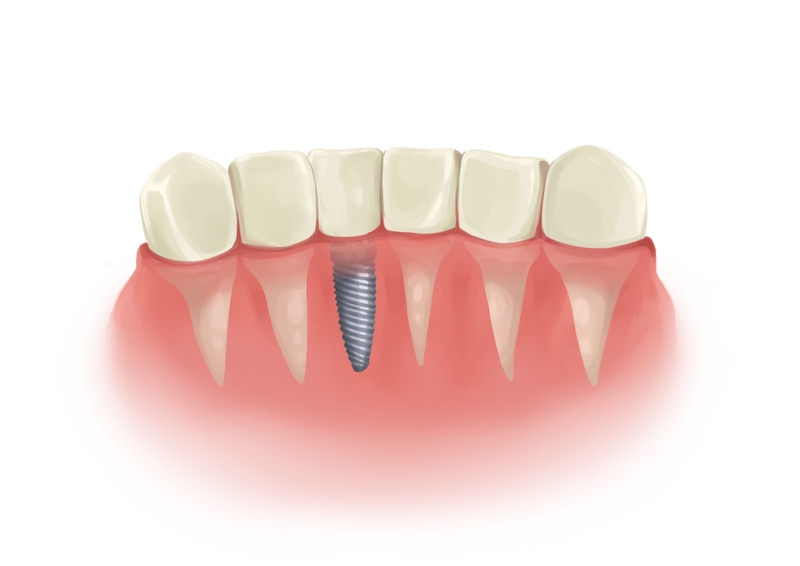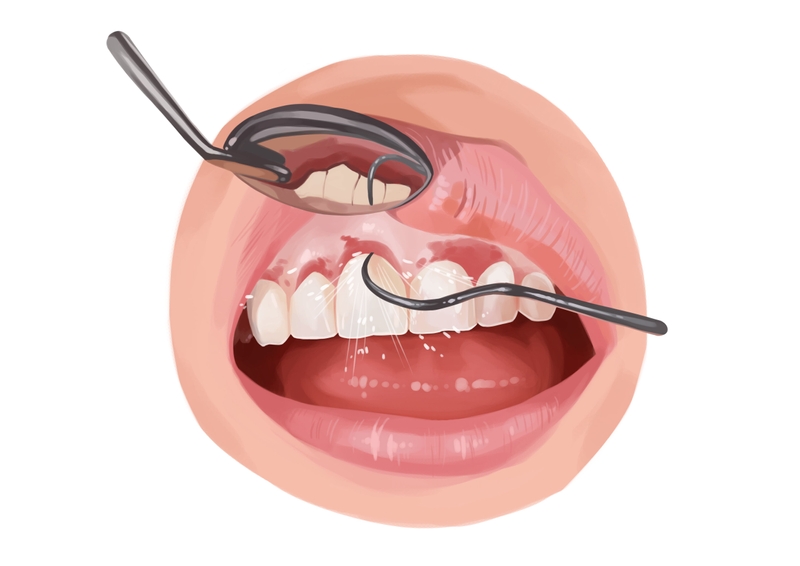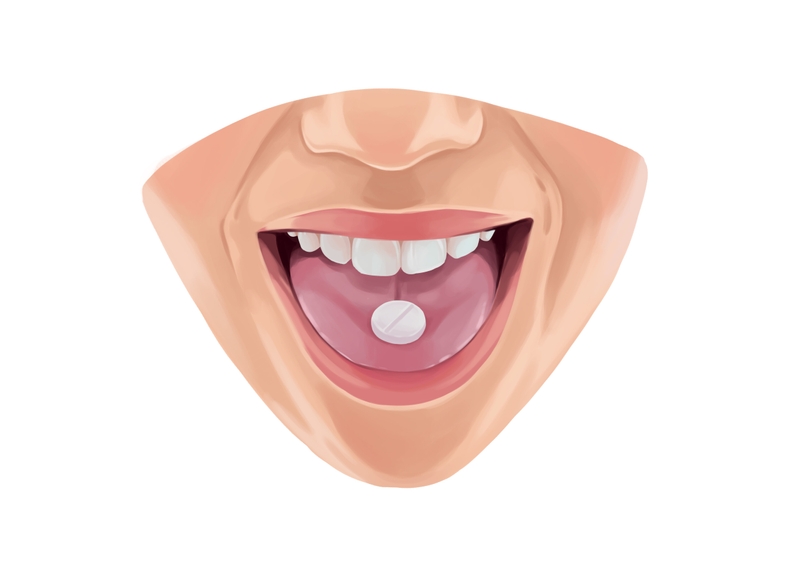- Risk factors for developing dental implant infection include poor oral hygiene, smoking, and previous periodontal disease.
- Symptoms of dental implant infection include swelling, changes in gum color, bleeding, and a loose implant. You may also develop fever, throbbing in the ear and pain that does not go away even with medication.
- Dental implant infection is treatable at early stages. Treatment methods include mechanical cleaning and surgical procedures.
Smile like never before, starting today. Use Authority Dental to book dental implant dentists near you. It's simple, fast and reliable.
Do you suspect you may have a dental implant infection? Here's everything you need to know.
Risk factors for dental implant infection

Picture by Authority Dental under CC 2.0 license
The most common causes of implant infection are:
poor oral hygiene,
smoking, and
previous periodontal disease.
Proper implant aftercare is vital. If you don’t brush and floss daily, you allow for the introduction and habitation of bacteria and fungus in the mouth. These gradually make their way towards the soft and hard tissues surrounding the implant. Infections may lead to a variety of dental implant problems.
Tobacco users have a higher concentration of an enzyme called arginase in their spit. It is argued that it lowers nitric oxide production. This makes saliva more acidic, creating a perfect environment for bacteria to thrive. Smokers are therefore more vulnerable to dental implant infections.
Patients with a history of periodontitis are also at higher risk. It certainly has to be treated before implantation can take place, but gum disease has a tendency to come back. Bone loss is likewise more prominent in such cases, leading to a larger rate of implant failure.
All in all, implant infection is almost always linked to patient-oriented risk factors. The following are worth noting, but the rate of infection caused by these is very low:
Dental implants infection symptoms
If you observe any of these signs, immediately contact your dentist:
swelling around the implant,
changes in the color of the gums,
bleeding from the implant site,
a fever,
throbbing in your ear, and
pain that doesn’t go away with medication.
Soreness is relatively rare in conjunction with implant infection, but if it is present, it usually means the problem is severe. Other causes for concern are similar to sinus lift and bone graft infection symptoms.
If you experience any of these symptoms, book an appointment with a 24/7 emergency dentist near you.
Dental implant infection symptoms also include a large probing depth of the peri-implant pockets and gradual bone loss in the affected area. Those, however, can only be diagnosed by a professional such as a dentist or periodontist.
Stages of dental implant infection
Tooth implant infection can be described in two stages. The first is referred to as peri-implant mucositis. When left untreated, it can transform into a more serious condition, peri-implantitis.
Both progress similarly to gum disease but may develop more rapidly. This is because the attachment of an implant is less durable than that of a natural tooth. Signs can even occur years after implant placement.
Peri-implant mucositis
Patients may experience inflammation of the soft tissues around the implant. When there is no bone loss to be detected, the infection is completely reversible. This does not mean, however, that the condition is not serious.
In more severe cases, surgical treatment might be necessary. One way or another, peri-implant mucositis should be dealt with as soon as possible to prevent further damage. If left unattended it could lead to future loss of the implant.
Peri-implantitis
The second stage of dental implant infection is called peri-implantitis. It affects the soft and hard tissues around the rod and is accompanied by bone loss in that area. This condition occurs after osseointegration, when the restoration (for example a crown) is already in place.
Peri-implantitis does not inevitably lead to implant failure. It can and should be treated as soon as symptoms become apparent.
How to treat a dental implant infection
First of all an X-ray will be done to determine whether there was any bone loss. This is followed by periodontal probing. This allows for accurate diagnosis of the stage of infection. Then, the dentist will suggest a treatment plan.
The following are the most popular remedies. Usually a combination is performed.
Mechanical cleaning

Picture by Authority Dental under CC 2.0 license
Shallow mucosal pockets can be cleaned with an ultrasonic device or carbon fiber curettes. This is called sub-mucosal debridement. The high-frequency waves allow the dentist to remove the contaminated material from around the implant.
If the mucosal pockets are 5mm or deeper your dentist might suggest polishing with a rubber cup and paste, mechanical flossing, or delicate scaling instruments. In such a case, the instruments have to go in deeper and it is important not to roughen the surface of the rod.
Mechanical debridement is often conducted in conjunction with locally administered antiseptic. This is only done if the pocket depth is larger than 4mm.
Surgical procedure
Surgical management of implant infection is generally performed when the rod is placed in a non-aesthetic site.
The gums are cut open and flapped back to allow better access to the contaminated area. A mechanical cleaning is performed, often in conjunction with antiseptics. This procedure is sometimes referred to as open-flap debridement.
This option comes with a lot of possible complications. The exposure of porous membranes can lead to further infection, especially during the healing period. It should only be performed if the other types of treatment fail.
Dental implant infection antibiotics

Picture by Authority Dental under CC 2.0 license
The dentist will examine the periodontal condition of the remaining teeth. On the basis of this information he or she will determine whether to administer antibiotics locally or systemically.
If peri-implantitis is limited to the immediate surrounding of the implant and there is no other disease present in the mouth, localized antibiotics might be prescribed. They will be distributed to the affected site for a few days.
If the infection is generalized to a larger area in the mouth, antibiotics might be delivered systemically. The same happens when the patient is simultaneously suffering from periodontitis.
Antibiotics treatment may have to be repeated within a few weeks or months.
Implant removal
If peri-implant mucositis has developed into peri-implantitis and a significant amount of bone was lost, the implant may have to be removed. This can be done with a surgical instrument called a trephine.
Alternatively, the dentist might decide to allow bone loss to continue up to a point when the implant can be extracted with forceps. This decision is made when there is less than 3 to 4 mm of supporting bone.
Some patients may qualify for reimplantation after bone grafting and several months of healing.
FAQ
Can an infected dental implant be saved?
Often, yes. If the infection is diagnosed quickly and treatment begins soon after symptoms appear, the implant can be saved.
It should be a very simple process if there was no bone loss. The most common treatment is a mechanical cleaning. You will likely get antibiotics and might have to undergo surgery.
Who treats dental implant infection?
Can I get dental implant infection years after surgery?
What happens if you don’t treat infection?
Infections in the mouth can grow rapidly. Peri-implantitis develops much faster than gum disease. It can lead to bone loss as well as failure of the implant. It is not uncommon for neighbouring teeth to suffer, too.
What’s more, an abscess could form and transfer bacteria into your bloodstream. If that happens you are looking at a serious, life-threatening situation.
How to prevent dental implant infection?
References
- Smoking increases salivary arginase activity in patients with dental implants
- Effect of periodontitis history on implant success: a long-term evaluation during supportive periodontal therapy in a university setting
- Management of peri-implantitis
- Peri-Implant Bone Loss and Peri-Implantitis: A Report of Three Cases and Review of the Literature
- Peri-implant mucositis
- Peri-Implantitis
- Comparative biology of chronic and aggressive periodontitis vs. peri-implantitis
- Peri-implant health, peri-implant mucositis, and peri-implantitis: Case definitions and diagnostic considerations
- Peri-implant mucositis
- Peri-implant diseases and conditions: Consensus report of workgroup 4 of the 2017 World Workshop on the Classification of Periodontal and Peri-Implant Diseases and Conditions
- Osseointegration
- Non-surgical therapy for the management of peri-implantitis: a systematic review
- Adjunctive Systemic and Local Antimicrobial Therapy in the Surgical Treatment of Peri-implantitis: A Randomized Controlled Clinical Trial
Richard Hattaway, DDS
Remember that the absence of pain does not always mean the absence of disease. This is why proper and timely dental exams are crucial.